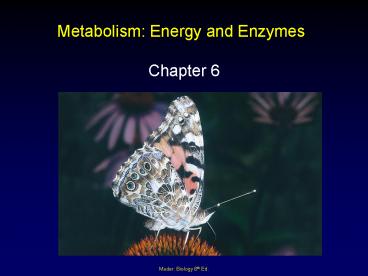Metabolism: Energy and Enzymes - PowerPoint PPT Presentation
1 / 29
Title:
Metabolism: Energy and Enzymes
Description:
Metabolism: Energy and Enzymes Chapter 6 – PowerPoint PPT presentation
Number of Views:147
Avg rating:3.0/5.0
Title: Metabolism: Energy and Enzymes
1
Metabolism Energy and Enzymes
- Chapter 6
2
Outline
- Forms of Energy
- Laws of Thermodynamics
- Metabolic Reactions
- ATP
- Metabolic Pathways
- Energy of Activation
- Enzymes
- Photosynthesis
- Cellular Respiration
3
Forms of Energy
- Kinetic - Energy of motion.
- Mechanical
- Potential - Stored energy.
- Chemical
4
Laws of Thermodynamics
- First law (law of conservation of energy) states
- Energy cannot be created or destroyed, but it can
be changed from one form to another. - Second law states
- Energy cannot be changed from one form to another
without a loss of usable energy.
5
Cells and Entropy
- Second law can also be explained as every energy
transformation makes the universe less organized
and more disordered. - Entropy
- Second law means that every cellular process
increases the total entropy of the universe.
6
Cells and Entropy
7
Metabolic Reactions
- Metabolism - Sum of cellular chemical reactions.
- Reactants and products
- Free energy is the amount of energy available to
perform work. - Exergonic Reactions - Reactants have more free
energy than products. - Endergonic Reactions - Products have more free
energy than reactants.
8
ATP
- Adenosine triphosphate (ATP) is constantly being
generated from Adenosine diphosphate (ADP). - Composed of adenine and ribose (adenosine) and
three phosphate groups.
9
ATP Cycle
10
Coupled Reactions
- In coupled reactions, the energy released by an
exergonic reaction drives an endergonic reaction.
11
Coupled Reactions
12
Function of ATP
- Chemical Work - Energy needed to synthesize
macromolecules. - Transport Work - Energy needed to pump substances
across plasma membrane. - Mechanical Work - Energy needed to contract
muscles, beat flagella, etc.
13
Metabolic Pathways
- Reactions are usually part of a series of linked
reactions. - Begin with a particular reactant and terminate
with an end product. - Enzymes are protein molecules that function as
organic catalysts to speed a chemical reaction.
14
Energy of Activation
- The energy that must be added to cause molecules
to react with one another is called the energy of
activation. - Enzymes lower energy of activation by bringing
the substrates into contact with one another.
15
Energy of Activation
16
Enzyme-Substrate Complex
17
Enzyme-Substrate Complex
- In most instances, only the active site complexes
with the substrates. - Active site undergoes a change in shape to
accommodate the substrates. - Induced fit model
18
Enzyme Speed
- Generally, enzyme activity increases as substrate
concentration increases. - More collisions between substrate molecules and
the enzyme. - As temperature rises, enzyme activity increases.
- Warmer temperatures cause more effective
collisions between enzyme and substrate.
19
Enzyme Speed
- If temperature rises beyond a certain point, the
enzyme becomes denatured and the enzyme activity
levels out. - Enzymes also have an optimal pH.
20
Enzyme Concentration
- Cells regulate which enzymes are present and/or
active. - Enzyme Cofactors
- Vitamins
- Phosphorylation
- Enzyme Inhibition
- Feedback Inhibition
21
Feedback Inhibition
22
Feedback Inhibition
- Most metabolic pathways are regulated by another
type of feedback inhibition. - End product of the pathway binds to an allosteric
site. - Binding shuts down the pathway, and no more
product is produced.
23
Oxidation-Reduction
- In redox reactions, electrons pass from one
molecule to another. - Oxidation is the loss of electrons.
- Reduction is the gain of electrons.
- Oxidation and reduction always take place at the
same time as one molecule accepts the electrons
given up by another molecule.
24
Photosynthesis
- Carbon dioxide water solar energy yields
glucose and oxygen. - 6 CO2 6 H2O energy ? C6H12O6 6 O2
- Chloroplasts capture solar energy and convert it
via electron transport chain to ATP. - Coenzyme active during photosynthesis.
- NADP 2e- H ? NADPH
25
Cellular Respiration
- Glucose oxygen yields carbon dioxide water
energy. - C6H12O6 6 O2 ? 6 CO2 6 H2O energy
- Most oxidations involve a coenzyme
- NAD 2e- H ? NADH
26
Electron Transport System
- A series of membrane-bound carriers that pass
electrons from one carrier to another. - High-energy electrons delivered, and low-energy
electrons leave.
27
ATP Production
- Chemiosmosis Production of ATP due to a hydrogen
ion gradient across a membrane.
28
Review
- Forms of Energy
- Laws of Thermodynamics
- Metabolic Reactions
- ATP
- Metabolic Pathways
- Energy of Activation
- Enzymes
- Photosynthesis
- Cellular Respiration
29
(No Transcript)































